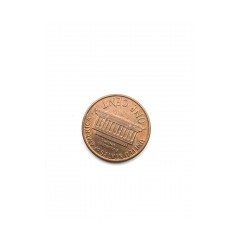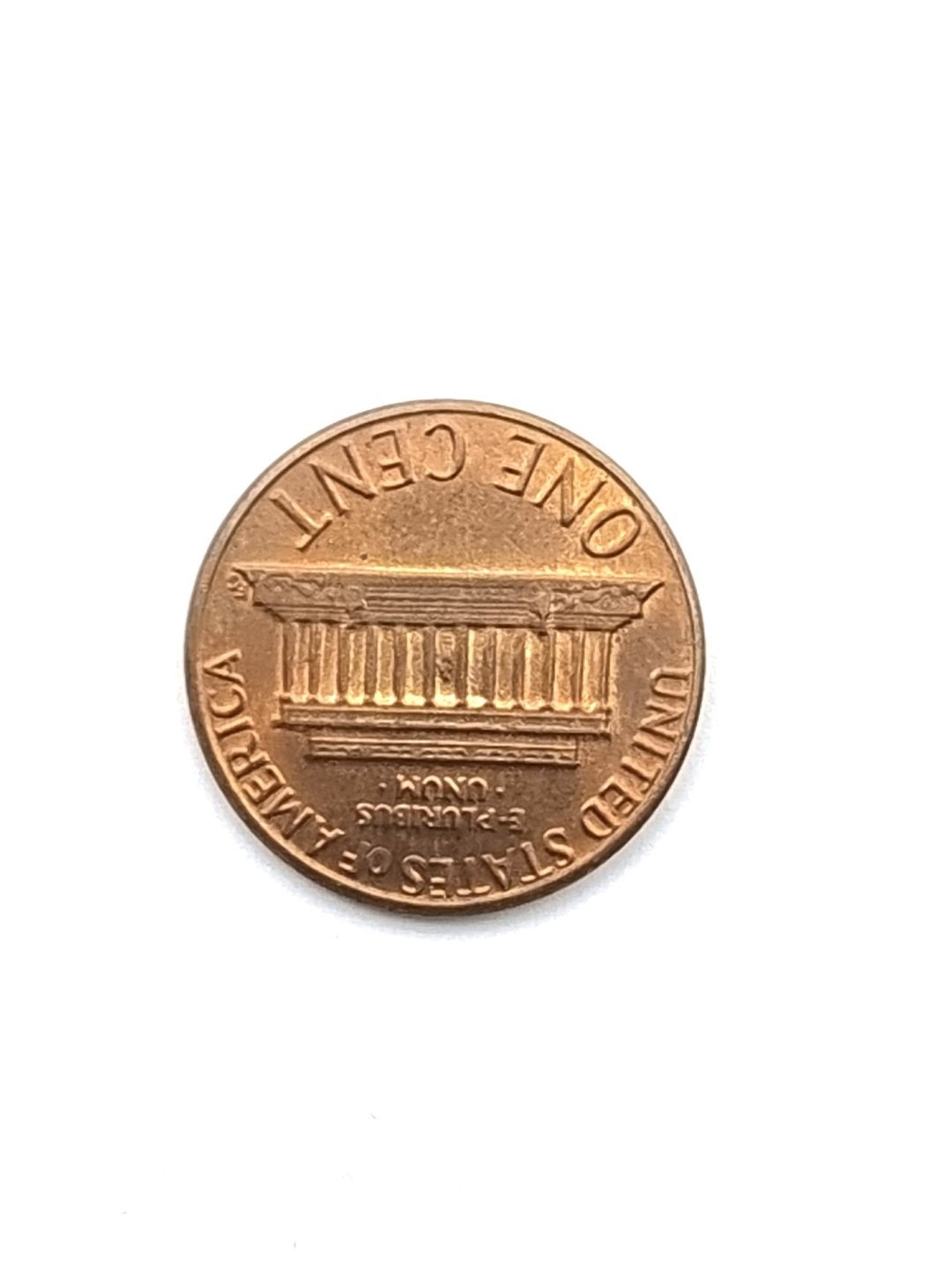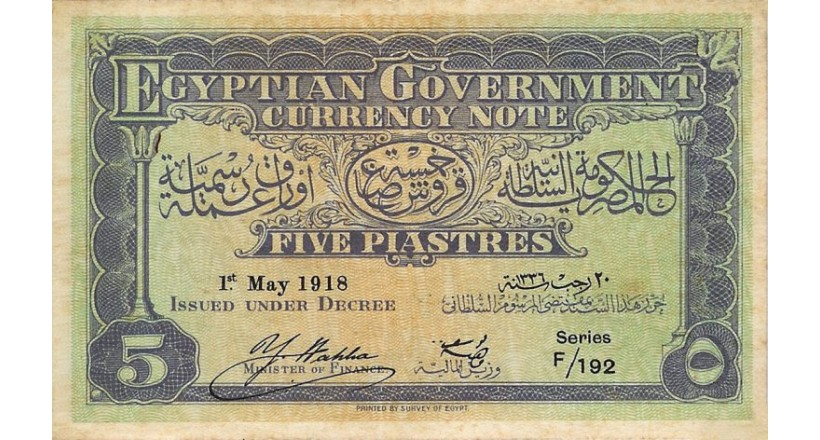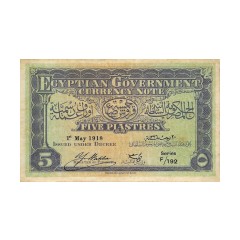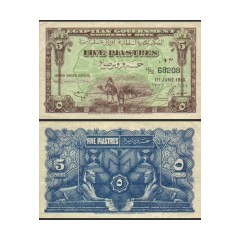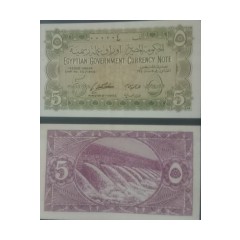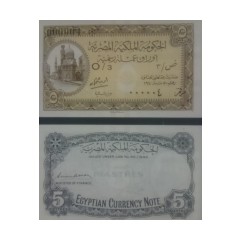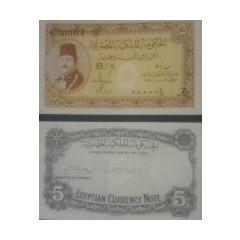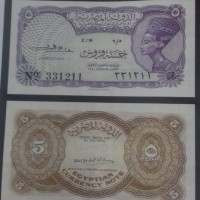Issuing currency notes (The Five and Ten Piastres) in Egypt
The issuing of the currency notes of 5 and 10 Piastres in Egypt, for the first time, was linked to
some crises that the country witnessed, and which were accompanied with a severe lack of metals
used in minting coins of 5 and 10 Piastres .. .Four phases marked the issuing of such notes :
First: During World War 1 (1914-1918)
The first appearance of currency notes in Egypt was during the first World War, in the reign of
Sultan "Hussein Kamel" The circumstances of war made it so difficult to import metals to Egypt,
used in minting coins. In such circumstances the real value of coins became higher than their nominal
one. The merchants and silversmiths took advantage of the situation and started melting the coins to
benefit from their real value of the metal. The lack of coins currency becoming even more severe, the
government had to issue currency notes of 5 and 10 piastres to keep the markets working. These issues
were printed in" De La R ue" press in London in 1916, That was before the issuing by government of
Act 13, dated the 15th. Of June 1918, concerning the issuing of 5 piastres bills.
At the time of Sultan "Fuad I" the Egyptian government issued a 5 piastres bill that was printed
at the "Survey of Egypt" in May the 1st 1918.That was before Act 14 dated 18 July 1918 enters into
effect. However these bills were easy to forge, due to the bad quality of paper, so the government
withdrew it from circulation, redesigned it, and reprinted it in "Bradbury Wilkinson & Co." Press in
London, on a high quality paper. These were dated June the 1st, 1918
After the war, the government stopped issuing those notes, but they remained in circulation till
1926 when the Ministers' Cabinet decided to stop their use and took them out of circulation, on the
11th. of February, 1926.
Second : During World War II (1939 - 1945)
The Same Reasons that made the government issue currency notes in WWI, made it issue
them again in WW II, during the reign of King "Faruk I". Act 50, dated 11 June 1940 was decreed
authorizing the issuing of 5 and 10 piastres currency notes.
The 10 Piastres notes were printed in brown, with the landscape of the Nile and Citadel on the
back of the note. The 5 piastres note, on the other hand, was printed in green, with a scene of the Aswan
dam on the back. Both were printed in the "Survey of Egypt", with no watermark. The 10 piastres was
later withdrawn from circulation, again due to instances of forgery, and was then reprinted, with the
same design, but on a better quality paper, and with a watermark for the first time; complicated
geometrical designs were added to the back of the paper, to make it harder to forge.
In 1942,a new design for both notes was introduced. The face of the 10 piastres having now the
Kiosk of Emperor "Trajan", the 5 piastres on have the mosque of "Khayer Bek" instead. Both bills
were printed in the "Survey of Egypt press, on a special paper bearing the water mark of the repeated
motifI [the Royal crown and the leter ( ف )
In 1944, the design of the 1o piastres bill was changed again. The portrait of King "Faruk I"
figured on its face for the first time Shortly after that, it appears on the 5 piastres too. Those notes
bearing the portrait of King Faruk" remained in circulation till the eruption of the 1952 revolution.
Third: The aftermath of 23rd of July 1962 revolution.
The issuing of both notes went on, shortly after the revolution. However the government changed the design completely, so it goes in harmony with the new ideology of the revolution.
Since then, up till now, the 5 piastres note bears a picture of the head of Queen "Nefertiti" on its
face. The only changed appeared in the name of the country. The design of the face of the 10 piastres
note, however, represented a panorama of all the groups forming the Egyptian community. Thus we see
a soldier with rifle; a peasant with an ax in hand; a worker with wrench; two women, one in an Egyptian
outfit, the other in a Sudanese one, symbolizing the unity of the Nile valley; and the Egyptian old flag
(the crescent and three stars) on the background..
The 5 and 10 piastres notes were issued in the name of the "Egyptian State", and printed on paper
already prepared before the revolution, and bearing the watermark of king Faruk's portrait. This
watermark was duly and carefully covered, so as to disappear, under the design motifs.
After this stock of paper was al used up, new paper was used. The watermark as well as the
name of the country changed several times, according to diferent political events.
The currency notes were at first printed and numbered in the "Survey of Egypt";then the "Post
Service" press look the responsibility of printing the 5 piastres notes, while the printing of the 10 piastres remained at the "Survey Authority" with the Rail Way press being now responsible for numbering and scissoring both notes.
The policies committee decided, in1989, to stop currency notes, and took it out of circulation; favoring the total dependence on coins.
Behind this decision was a feasibility study commissioned by the committee. According to this study,
the cost of both, the currency notes, and the coins is 3 piastres; but, while the life time of the first is
3-6 months, that of the latter can reach 20 years.
Fourth Issues following the 1997 crisis onward :
On the 2nd of April. 1997,the Ministers Cabinet agreed on the reprinting of the currency notes
Of 5 and 10 piastres. This was a response to a crisis in the coins, which lasted from 1995 to 1997.
The 5 and 10 piastres notes were reprinted again, starting 1998, at the "Post service" and
"Survey Authority" press on papers having a watermark of the mask of King "Tut Ankh Amon"
However a fatal mistake occurred in the 5 piastres bill: old zink plates were used; they bore the
signature of a former minister of finance "Salah Hamed" in English: the face of the paper, however,
bore the signature of the then minister of finance "Mohey El Din El Gharib" in Arabic To solve the problem the Central Bank was commissioned the printing of the currency aoies of 5 and 10 piastres, due to the high-tech of his press.
Thus the Central Bank Press became the only party responsible for printing all paper money in Egypt, from the 5 piastres bill, to the 100 pound one.
The 5 piastres currency note was populary known as "Shelling" (pronounced ‘shelen’
by the Egyptians), and the 10 Piastres as "Bariza".
The Egyptian "Rial" was equivalent to 4 English Shellings. The "Rial" was also 20 Egyptian Piastres, so it was fair enough to call the 5 Piastres note: Shelling (or Sheln) As for the word "Bariza", the popular name of the 10 Piastres currency note, it came from the word "Paris", capital of France (pronounced by the commoners: Baris or Bariz), and the French word for 10 (Dix). Both words were combined in the Egyptian tongue to form "Bariza" meaning 10 Piastres.


